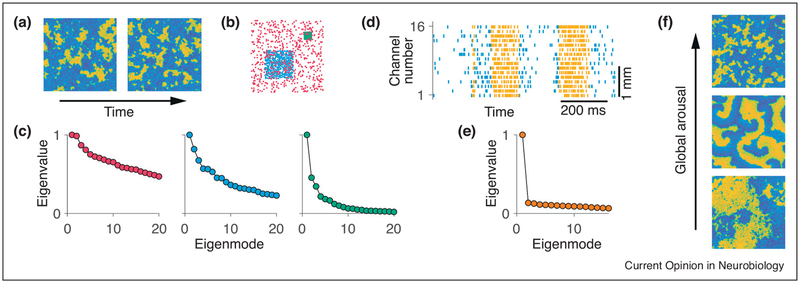Figure 2.
The spatial scale of network dynamics determines the dimensionality of correlated fluctuations. (a) Spontaneous activity patterns in a two-dimensional network model of rate-units with spatially structured connectivity [27]. The network exhibits spatiotemporal activity with high (yellow) and low (blue) firing-rates clustered in space. The activity spreads through the network as local irregular waves. The typical cluster size depends on the spatial connectivity strength and local excitability. (b) Activities of 625 units in the network are sampled over time on spatial scales that are large (red), medium (blue) and small (green) relative to the typical cluster size. Dots indicate locations of the sampled units. (c) Eigenvalue spectra of the activity correlation matrix of units sampled on the large (red, left), medium (blue, middle) and small (green, right) scales. The activity is high-dimensional on scales larger than the typical cluster size, and low-dimensional on scales smaller than the typical cluster size. (d) Spontaneous transitions between periods of high (yellow) and low (blue) spiking activity recorded across layers of a single column in the primate visual cortex with a 16-channel linear multi-electrode array (data from Ref. [25••]). One example trial is shown. (e) Eigenvalue spectrum of the activity correlation matrix of units within a single column from panel (d). The single-column activity is dominated by one dimension. (f) Changes of behavioral states (e.g. global arousal), accompanied by changes in the level of neuromodulators that affect neural excitability (e.g. acetylcholine, ACh), can lead to qualitative changes of spatiotemporal activity patterns in the network (without any change in the network connectivity). The activity pattern in the network model shifts from global synchronous waves (lower panel), to spiral waves (middle panel), to local irregular waves (upper panel) when neural adaptation currents are enhanced, mimicking the effect of rising ACh level. Such shifts in spatiotemporal dynamics will produce changes in the dimensionality of correlated fluctuations in the same group of neurons.

